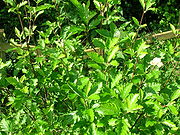
Sorbus arranensis
Encyclopedia
Sorbus arranensis, sometimes referred to as the Scottish or Arran Whitebeam is a species of plant
in the Rosaceae
family. It is endemic to the island of Arran
in Scotland.
, and are monitored by staff from Scottish Natural Heritage
. In its native states its distribution is restricted to Abhainn Bheag (Uisge Solus), Glen Diomhan (and tributary), Glen Catacol, Allt nan Calman, Allt Dubh, Gleann Easan Biorach and Glen Iorsa (Allt-nan-Champ). The trees are found in small remnants of woodland on inaccessible steep slopes, and grow on acidic soils.
S. arranensis, evoked most collecting interest in 1870–1890 and 1920–1940, although older herbarium
specimens exist.
 The Sorbus group are apomictic, producing viable seed without the need for pollination and fertilisation. Each time this hybrid cross occurs a new clone
The Sorbus group are apomictic, producing viable seed without the need for pollination and fertilisation. Each time this hybrid cross occurs a new clone
is effectively produced. The trees developed in a highly complex fashion, which involved the Common whitebeam (Sorbus aria) giving rise to the more robust Rock Whitebeam
(Sorbus rupicola) which is still found on Holy Isle
. This hybrid species interbred with the Rowan
/Mountain Ash (Sorbus aucuparia) to produce S. arranesis. The Bastard Mountain Ash
(Sorbus pseudofennica) arose from a further cross between S. arranensis and the Mountain Ash (S. aucuparia).
Smart showed by using physical characteristics that the species were separate and not a result of random variation. Some overlap does however occur and this suggests that some hybridising may occur between the two species.
Plant
Plants are living organisms belonging to the kingdom Plantae. Precise definitions of the kingdom vary, but as the term is used here, plants include familiar organisms such as trees, flowers, herbs, bushes, grasses, vines, ferns, mosses, and green algae. The group is also called green plants or...
in the Rosaceae
Rosaceae
Rosaceae are a medium-sized family of flowering plants, including about 2830 species in 95 genera. The name is derived from the type genus Rosa. Among the largest genera are Alchemilla , Sorbus , Crataegus , Cotoneaster , and Rubus...
family. It is endemic to the island of Arran
Isle of Arran
Arran or the Isle of Arran is the largest island in the Firth of Clyde, Scotland, and with an area of is the seventh largest Scottish island. It is in the unitary council area of North Ayrshire and the 2001 census had a resident population of 5,058...
in Scotland.
Range and habitat
The species is threatened by habitat loss and only 283 Sorbus arranensis were recorded as mature trees in 1980. The species is protected in Glen Diomhan off Glen Catacol, at the north end of the island by a partly fenced off National Nature ReserveNational Nature Reserve
For details of National nature reserves in the United Kingdom see:*National Nature Reserves in England*National Nature Reserves in Northern Ireland*National Nature Reserves in Scotland*National Nature Reserves in Wales...
, and are monitored by staff from Scottish Natural Heritage
Scottish Natural Heritage
Scottish Natural Heritage is a Scottish public body. It is responsible for Scotland's natural heritage, especially its natural, genetic and scenic diversity. It advises the Scottish Government and acts as a government agent in the delivery of conservation designations, i.e...
. In its native states its distribution is restricted to Abhainn Bheag (Uisge Solus), Glen Diomhan (and tributary), Glen Catacol, Allt nan Calman, Allt Dubh, Gleann Easan Biorach and Glen Iorsa (Allt-nan-Champ). The trees are found in small remnants of woodland on inaccessible steep slopes, and grow on acidic soils.
S. arranensis, evoked most collecting interest in 1870–1890 and 1920–1940, although older herbarium
Herbarium
In botany, a herbarium – sometimes known by the Anglicized term herbar – is a collection of preserved plant specimens. These specimens may be whole plants or plant parts: these will usually be in a dried form, mounted on a sheet, but depending upon the material may also be kept in...
specimens exist.
Evolution

Cloning
Cloning in biology is the process of producing similar populations of genetically identical individuals that occurs in nature when organisms such as bacteria, insects or plants reproduce asexually. Cloning in biotechnology refers to processes used to create copies of DNA fragments , cells , or...
is effectively produced. The trees developed in a highly complex fashion, which involved the Common whitebeam (Sorbus aria) giving rise to the more robust Rock Whitebeam
Whitebeam
The whitebeams are members of the Rosaceae family, comprising subgenus Aria of genus Sorbus, and hybrids involving species of this subgenus and members of subgenera Sorbus, Torminaria and Chamaemespilus. They are deciduous trees with simple or lobed leaves, arranged alternately...
(Sorbus rupicola) which is still found on Holy Isle
Holy Isle, Firth of Clyde
The Holy Isle, Firth of Clyde is one of a number of islands in the United Kingdom which go under the name "Holy Island". It is located in the Firth of Clyde off the west coast of central Scotland, inside Lamlash Bay on the larger island of Arran.- Details :The island is around long and around ...
. This hybrid species interbred with the Rowan
Sorbus aucuparia
Sorbus aucuparia , is a species of the genus Sorbus, native to most of Europe except for the far south, and northern Asia...
/Mountain Ash (Sorbus aucuparia) to produce S. arranesis. The Bastard Mountain Ash
Sorbus pseudofennica
Sorbus pseudofennica is a species of plant in the Rosaceae family. It is a naturally occurring hybrid caused by the Rock Whitebeam hybridising with the Rowan , then crossing back with S. aucuparia...
(Sorbus pseudofennica) arose from a further cross between S. arranensis and the Mountain Ash (S. aucuparia).
Smart showed by using physical characteristics that the species were separate and not a result of random variation. Some overlap does however occur and this suggests that some hybridising may occur between the two species.

